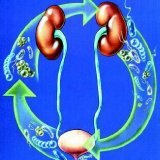Treatment of urinary tract infections caused by Klebsiella

Quite dangerous intestinal bacteria that affect humans are Klebsiella. According to many data, Klebsiella is the most resistant to antibiotics, rather than the E. coli, and its release from purulent exudates, blood and urine have an order of magnitude greater prognostic and epidemiological significance.
Itay, now we will examine the treatment of infections of the urinary tract caused by klebsiella.
Klebsiella intestinal infection, quite similar to the bacteria of the genus Enterobacter and Serratia, and they can only be distinguished with the help of special decarboxylase amino acid probes. It should be noted that the bacteria of the Klebsiella strain are usually immobile and usually form large mucous colonies on the surface of dense media, while other species are more mobile. Klebsiella strains also differ on the basis of capsular type-specific antigens.
This bacterium can cause disease in various anatomical areas. However, the results of epidemiological and clinical studies allow us to propose a version of the fact that among the representatives of this genus microorganisms there are differences in the degree of their pathogenicity, and their precise identification of taxonomy has a definite value. In the past, Klebsiella-intestinal secretions were mainly isolated from respiratory infections. Despite this, at the moment most of those isolated from clinical strains are also found in urinary tract infection. Pathogenesis and clinical manifestations of these infections are similar to those caused by E. coli, however, klebsiella is more often found in patients with obstructive and complicated urinary tract involvement. Also, infectious lesions in the biliary tract, mastoid process of the abdominal cavity, middle ear, soft meninges, and paranasal sinuses are quite common. At these locations klebsiella is detected more often than other bacteria and with a high degree of probability causes the most serious diseases.
Symptoms and signs.
Symptoms and symptoms of infection that are caused by Klebsiella, including urinary tract, abdominal and biliary tract infections do not differ from the symptoms of infections that are caused by E. coli. It develops as a rule in diabetic patients, also besides this, is observed in the form of super-infection in patients who receive antimicrobial drugs, to which the causative agent has a stable reaction. Also, the Klebsiella bacterium is a very important factor in the etiological plan of septic shock.
This intestinal infection is fairly well known in pulmonary diseases as a pathogenic agent, but it accounts for less than 1% of cases of bacterial pneumonia. This disease is typical, as a rule, for men aged 40 years and is often detected in patients with alcoholics. Also, the factor that causes high sensitivity to this disease are bronchopulmonary diseases and diabetes mellitus. Alcoholics developing an infection initiative is aspiration of the oropharyngeal secretion, which contains Klebsiella. And the clinical manifestations are very similar to the sympomas that are observed in pneumonia and are characterized by a sharp chill, productive cough, increased body temperature and severe pleural pain. Patients may be in a state of prostration and delirious, but it should be noted that the same consequences can be detected in pneumococcal pneumonia. In the lungs, the focus of the disease will be more often located in the upper right lobe and progresses quite rapidly. If treatment does not occur, then the infection is transferred from the right lobe to the left. Quite quickly, dyspnea and cyanosis develop, vomiting, jaundice, and diarrhea can also occur.
The examination reveals the compaction of lung tissue. This is due to the formation of necrotizing pneumonia or pleural effusion with rapid cavernization. The percentage of leukocytes in the blood can be increased, but often it is low, which is likely a consequence of severe manifestations of infection in alcoholics, with a deficiency of folate and inadequate stocks of bone marrow. Quite often empyema and abscess of the lungs are observed, more often than with pneumococcal infection. This is explained by the fact that klebsiella can cause tissue destruction. Rarely, a characteristic radiographic symptom can be identified, for example regional emphysematous changes and a decrease in lung volume due to its compaction. Also it is worth considering that these same symptoms can be caused by pneumococcal pneumonia and necrotizing infection, which is caused by other bacteria.
Treatment of infections of this type.
Intestinal infection of this type has a different sensitivity to antimicrobial drugs. Usually, antimicrobial treatment should be started before the results of antibiotic susceptibility testing have been obtained. In general, most strains of Klebsiella are sensitive to cephalosporins and aminoglycosides of the third generation. Strains from patients with Klebsiella are insensitive to almost all analogs of penicillin, but the growth of many of them is stopped by newer ureidopenicillins, or rather mezlocillin.
Treatment of urinary tract infections caused by Klebsiella may vary depending on the severity of the infection, as well as the nature of drug resistance. In severe cases of the disease, it makes sense to prescribe combined aminoglycosides, such as amikacin, tobramycin or gentamicin, with cephalirin, cephalothin or cefazolin. New cefamycins or cephalosporins and third-generation compounds may also exhibit positive activity against a Klebsiella infection.
Sometimes the drugs may be more active than the older generation of cephalosporins, and a drug sensitivity test is needed to select the appropriate treatment. Because of the low concentration of polymyxins that are created in tissue and blood when using these drugs, they do not need to be used as first-line drugs in the treatment of severe infections that caused klebsiella, even despite obvious sensitivity to them. In spite of the drug regimen that is used, treatment should be carried out for 10 to 14 days and further, in the event that a widespread cavity is noted. With imprints in the pleural cavity, the use of such antimicrobial agents is not sufficient for complete treatment. Quite often it happens, when a rib resection with open drainage is necessary. Such a tactic takes place when there are recurrent effusions.
Can be used in the treatment of Klebsiella - intestinal infection, folk remedies: oak bark, rice broth, broth of pomegranate crusts and so on.



